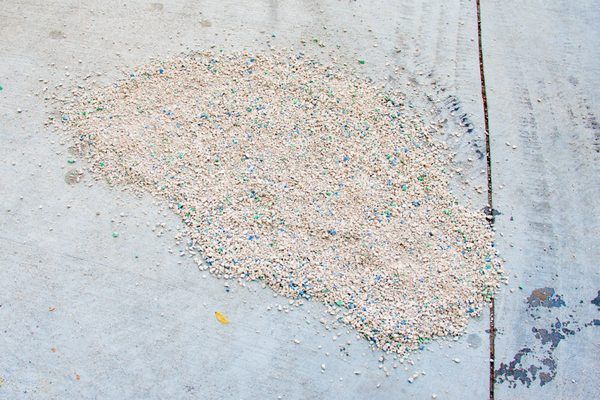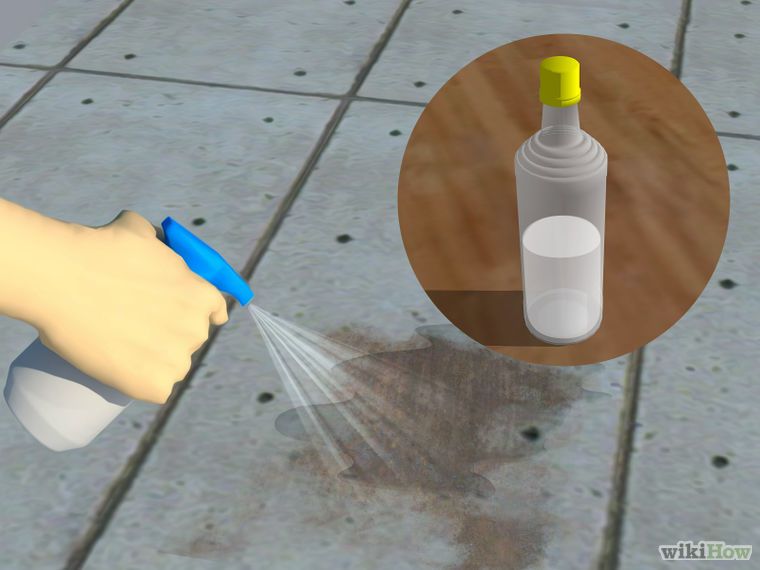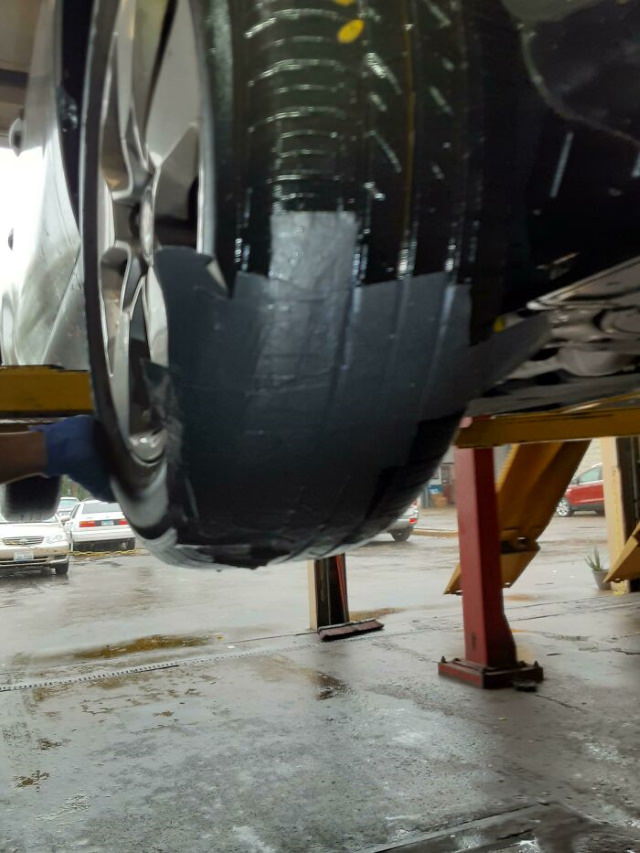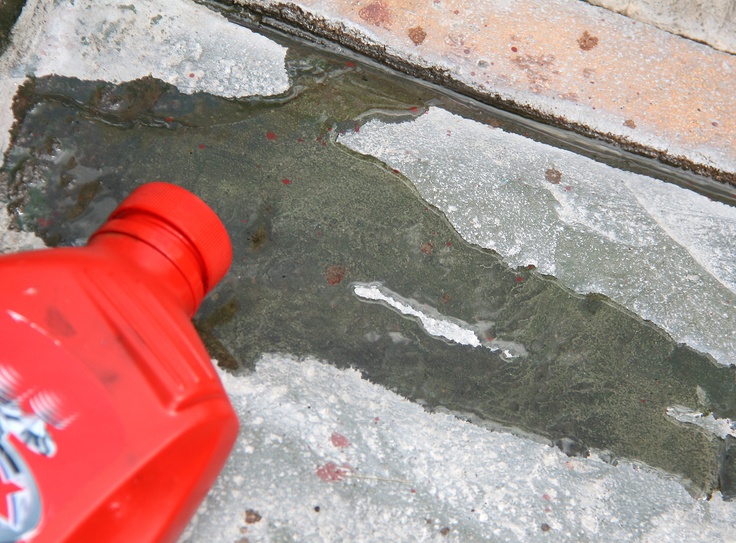A concrete driveway might be a solid and durable option but it has one major flaw. Due to its porous nature, it’s quite easy for one to stain and show those black tire marks.
These marks happen if you spin your wheels too fast while driving. They can also happen if you let your car sit on the concrete driveway for a long period of time.
Although it might be quite tricky, you can still manage to remove those pesky marks from the concrete. So without further ado, if you want to know how to remove tire marks from a concrete driveway, keep on reading this brief guide!
The simplest way to clean a tire mark on concrete is by clearing the floor from any debris, then apply a suitable degreaser to scrub the tire marks off the driveway.
If this method doesn’t work, you should opt for a power washer to help you flush away the marks using water pressure.
Before starting, make sure that you sweep off the driveway to remove as much dirt, debris, and fallen leaves as possible.
The empty and cleared-up driveway will show you any potential spots that also require cleaning along the way.
Concrete is pretty durable against physical pressure but it breaks down easily under the power of harsh chemicals.
Some of these chemicals can ruin your concrete driveway permanently either by damaging or discoloring it.
This also applies to some household cleaners such as bleach. Besides discoloring the concrete floor, especially colored one, it can also damage all surrounding plants and soil it can reach.
Always make sure that you check your driveway for any skid marks and make sure that you clean them up in the earliest convenience
The sooner you deal with the marks, the easier it’s going to be, which saves you both the time and costs of cleaning tools and materials.
Concrete is made by mixing cement with a paste of sand and water. Since the cement is made by blending a wide variety of ingredients, the final composition of concrete can be altered slightly.
These simple changes in the recipe of the concrete may show drastic variations when combined with certain chemicals.
In other words, even if you use a concrete-specific degreaser or cleaner, it’s always recommended that you test it out on a small scale and see if it’s a good fit before you run into unfortunate surprises.
A metal wire brush is a wonderful solution to remove any stubborn stain. While it may help you remove the tire marks off the driveway, it’s extremely abrasive and will easily ruin your driveway by leaving permanent scrapes or scratches where you used it.
Here are a few effective methods to get rid of the skid marks on concrete driveways. They’re arranged from the simplest to the most effective, although you can combine them together for maximum efficiency:
They’re arranged from the simplest to the most effective, although you can combine them together for maximum efficiency:
Mix some mild dish soap with warm to hot water in a bucket, then splash some of the solutions on the tire marks.
Allow the mix to sit for 5 minutes to soften the brunts of rubber, then use a broom with stiff bristles or a deck brush to scrub the tire marks off. This should be enough for mild tire marks and recently created ones.
We recommend using Dawn Dishwashing liquid because it has a degreasing quality that works with slightly more stubborn tire marks.
For tougher and relatively old tire marks, you might need to use a commercial concrete degreaser to remove the tire marks off your driveway.
There are plenty of good concrete degreasers out there, such as Simple Green and Drive Up. They’re both great for cleaning the concrete driveway and removing a variety of stains, including tire marks.
Pour some of the degreasers on the tire marks and allow it to sit for 15 to 30 minutes, but make sure that you don’t let it dry out by adding a few more when it’s drying up.
When the time comes, pour some water with a garden hose on the degreaser and scrub it with a deck brush, then rinse off the degreaser completely.
For the toughest tire mark stains, you might need some mechanical power added to the chemical power of concrete degreasers. The best solution here is to use a power washer, also known as a pressure washer.
Try to use the power wash on the lowest setting possible until you get the hang of it and avoid staying in on spot for long because it can damage your concrete.
You might also be interested in our blogs
How to Clean Brakes without Taking Wheels Off
How to Clean Raised White Letter Tires
How to Clean Rims and Tires
How to Get Rust off Wheel Rims
How to Remove Tar from Car Tires
How to Remove Plasti Dip from Car Tires
How to Remove Paint from Car Wheels
With that said, you now know how to remove tire marks from a concrete driveway. As you can see, cleaning those tire marks may require some elbow grease and is a bit tricky.
As you can see, cleaning those tire marks may require some elbow grease and is a bit tricky.
Yet, it’s a manageable process that you can still do without needing to call for professional help. And remember, while cleaning a concrete driveway, the “Don’ts” are as essential as the “Do’s”, so make sure that you always keep them in mind.
Skip to content
Share
Poured concrete and paving stones differ in many ways, including durability, skid resistance and the capacity to increase the value of your home. However, they are similar in one: They are both porous materials that can stain or become discolored from tire marks. Sealers can help, but skid marks and tire scuffs can occur on any of the popular driveway materials, including concrete, bricks, natural stone and pavers. They can even occur on asphalt; however, tire marks are generally not as noticeable on asphalt driveways.
They can even occur on asphalt; however, tire marks are generally not as noticeable on asphalt driveways.
If you have unsightly tire marks on your driveway that are taking away from your home’s visual appeal, this guide will help you remove the marks and bring your driveway back to its former luster.
Before we go into how to remove skid marks and tire scuffs from concrete and paving stones, we need to address a few things you should not use or do.
1. Do not use a wire brush.
Stiff, metal wire brushes can leave noticeable marks on any type of stone, paver or concrete surface. These will normally look like scratches or scrapes and will detract from the appearance of your driveway.
2. Do not use bleach.
Bleach is not an environmentally friendly option, particularly if you will be rinsing down your driveway after cleaning it, which could introduce the bleach into surrounding soil, groundwater or storm drains. It is also not a good idea to use bleach on colored concrete, because it may discolor the area in which the bleach was used.
3. Avoid harsh chemicals.
Concrete cleaners made from harsh chemicals may remove stains and marks effectively, but they can also discolor or damage concrete or stone surfaces. Using a strong solvent or other chemicals on a sealed driveway can also degrade or strip the sealer.
4. Do not let the mark sit any longer than necessary.
While it is not impossible to remove older stains, it is much easier to remove marks, scuffs and other discolorations soon after they occur.
How to Remove Tire Marks from Concrete and Paving StonesRemoving Tire Marks Step 1: Before moving to harsher solutions, the first thing you should do is try removing tire marks with water and a bristle brush or broom. In some cases, this will be enough to get the job done and will save you from spending money on commercial cleaners or having to worry about rinsing those cleaners into your landscaping or a storm drain.
Removing Tire Marks Step 2: If plain water does not work, the next step is to try a mixture of dish soap and water. Dish soaps with mild degreasing qualities can help lift the mark from the concrete without harsh chemicals. After applying your mixture of dish soap and water, scrub the area with a bristle brush (e.g. a deck brush), and then rinse with water.
Removing Tire Marks Step 3: If neither of the above solutions works to remove tire marks from your driveway, you can opt for a commercial degreaser designed for use in removing stains from concrete and paving stones. If you go this route, follow the directions provided by the manufacturer, wear eye and skin protection, and try to avoid rinsing the degreaser into nearby soil or gutters that drain into waterways. It is generally considered a good idea to try to stick with water or a mild dish soap if your driveway is sealed.
It is also possible to try to remove the marks with a pressure washer; however, this should either be left to a professional or done very carefully. Be sure to test this method out in an inconspicuous area first, since improper pressure washing can cause significant damage. If the pressure is too high or if you do not continuously move the pressure washer wand, it can leave unsightly marks on your driveway. Also keep in mind that using a pressure washer on paving stones may dislodge the joint sand, which will need to be replaced.
Be sure to test this method out in an inconspicuous area first, since improper pressure washing can cause significant damage. If the pressure is too high or if you do not continuously move the pressure washer wand, it can leave unsightly marks on your driveway. Also keep in mind that using a pressure washer on paving stones may dislodge the joint sand, which will need to be replaced.
One of the many advantages of having a paving stone driveway is that stained pavers can be removed and replaced without affecting the overall look of your driveway if stain removal methods are not effective. This is not possible with poured or stamped concrete.
How to Prevent Tire Marks and Skid Marks on Concrete and Paving StonesHave you ever noticed how some driveways seem to be more susceptible to tire marks than others? This is largely due to the use of different sealers. Tires have plasticizers that leach from the rubber when it gets hot. This interacts with different sealers in different ways. For example, if your driveway seems particularly susceptible to getting tire marks, you may have an acrylic sealer with a lower level of cross linking. Resealing it with an epoxy or polyurethane sealer with a higher level of cross linking may help prevent future tire marks.
For example, if your driveway seems particularly susceptible to getting tire marks, you may have an acrylic sealer with a lower level of cross linking. Resealing it with an epoxy or polyurethane sealer with a higher level of cross linking may help prevent future tire marks.
Photo Credits (in order of appearance): morgueFile, Alvimann; morgueFile, DuBoix
Get a Free Estimate →
Hidden
FormClass Make a paste of 1 part warm water and 3 parts baking soda in a small bowl. Apply the paste on the stain and leave for 5 minutes. If the stain is persistent, leave on for 15 minutes. Scrape off the paste with a toothbrush and tissue, and then wipe off any excess paste with a clean rag.
If the stain is persistent, leave on for 15 minutes. Scrape off the paste with a toothbrush and tissue, and then wipe off any excess paste with a clean rag.
Traces of from rubber, shoe polish and other oily substances can be carefully removed with gasoline. In the absence of fleecy fabric in the household, it can also be useful for removing stains from candles.
Pre-treat oil stains and tire marks before attempting to clean the entire surface. This can be done by covering the stains with laundry detergent. Pour a generous amount of detergent directly onto the stain.
Buy regular glycerin from a pharmacy, mix 100 grams of glycerin with 100 grams of water, then apply with a sponge to the rubber. Do not spare water, otherwise dust will stick to tires . Another tires are blackened with silicone oil, which will save tires in cold weather, protect against cracks and sunlight that age rubber.
It is safe for rubber but effectively removes yellowness. If the product is small, it can be completely immersed in liquid. When this is not possible, peroxide is applied to a cotton pad and treated with stain .
If the product is small, it can be completely immersed in liquid. When this is not possible, peroxide is applied to a cotton pad and treated with stain .
Mix water and baking soda, apply the mixture on the stain, let it dry, and finally rinse the area with warm, clean water. Spot on on paper wallpaper try to treat with dry baby powder (or talcum powder) and leave for a while.
If putty has ingrained into the structure of linoleum, it can be removed with mineral spirits. Traces of adhesive tape or plaster, on which dirt and dust have stuck, can be easily removed with vegetable oil or vodka.
Yellow spots on linoleum while still fresh, wash with a warm solution of 72% laundry soap. To do this, it must be grated on a fine grater and dissolved in warm water (100 g of chips per bucket of water). Soak a sponge, cloth or brush in the resulting solution and work spot . Then wipe the floor dry.
Within 5-7 minutes the bleach will react with the pigment and the stain will gradually disappear. Instead of pure bleach, you can use ready-made products containing chlorine, such as Domestos or Whiteness. Important! After bleaching on dark linoleum, whitish traces may remain.
Instead of pure bleach, you can use ready-made products containing chlorine, such as Domestos or Whiteness. Important! After bleaching on dark linoleum, whitish traces may remain.
Laundry detergent will react with wet asphalt and then begin to peel off dirt from the surface layer of asphalt . 4. Mix the cleaning agent with water in a container. The proportion of the solution is the following proportions, 1 part washing powder, 3 parts water and 1 part laundry bleach.
It is necessary to quickly cover it with sand, caustic soda or cement, and then simply remove all . Remaining stains can be washed off with solvent (solvent, white spirit, etc.), detergents.
As soon as a stain of engine oil or diesel fuel appears on asphalt , it is covered with sand, cement, caustic soda. Then they sweep away the remnants, wash everything off with water from a hose or a watering machine. Mechanical cleaning is not recommended.
Siral powder (or pemolux - less foam from it) + fine fine sand, mix, add water (not much) so that the consistency is - a la ice cream 5-10 minutes after getting out of the refrigerator . .. .. you can stupidly and in fairies throw a little abrasive .... the very collective farm - a helmet for rubber - and forward !!!
.. .. you can stupidly and in fairies throw a little abrasive .... the very collective farm - a helmet for rubber - and forward !!!
Often we washed the wheels by simply placing them in a bowl of water and slowly turning it in the water to wash away all the dirt. The wheel (rims and spokes) are not afraid of water, but after washing with a jet, it is still better to wipe them again with a sponge, and then with a dry cloth.
Substances such as nail polish remover (acetone), gasoline, kerosene, turpentine are aggressive to many materials. Use them very carefully.
…
Vinegar and whiteness
| Tire brake marks on concrete road are much more visible than on tarmac and they give your road a ghostly look. Braking suddenly at high speed, grabbing car wheels, is the most common cause of brake marks. Follow these proven steps to remove brake marks from your particular road, and learn how to prevent future brake marks. Step 1: Prepare Yard Near Concrete Road Remove container plants and cover any flowerbeds and trail lights, nearest brake tracks with a light plastic tarp loaded with bricks or rocks. Move any toys or bikes away from the road. Step 2: Rent or Borrow a 9 Hot Water Pressure Washer0003 For this task you will need a hot water pressure washer rated up to 3000 psi to remove the hard rubber strip off the concrete surface. Concrete must be rated to withstand 4000 psi pressure, the standard building material for roads. Spray the brake tracks for 2 to 3 minutes with pressure water with water hot enough to generate some steam. Step 3: Soak Brake Tracks With Industrial Strength Degreaser You can get industrial degreaser cleaners at your hardware or auto parts store. Apply a degreaser and let it soak into the brake marks for 10 minutes. Step 4: Clean Brake Marks Using a bristle broom, brush over brake marks to lift off rubber particles. Step 5: Rinse Brake Track SpotsAdjust pressure washer to lower temperature, warm but not steaming, and rinse off brake track areas. Point the pressure washer nozzle down the road to the driveway, not to your lawn and flower beds. Finish with a rinse at the coolest pressure washer setting. Step 6: Road 9 squeegee0003 With a squeegee, pull as much water off the concrete road as you can. Let the road dry for 3 to 4 hours, and park cars on the road. Step 7: Coat Your Road With Penetrating Insulator Buy a clear penetrating concrete sealant for your driveway. Apply it to the road when it has dried completely using a squeegee. Create an even layer of sealant over the whole road to shield it from rubber brake tracks. Avoid using film-forming sealer because they create a slippery surface and may change the color and appearance of your particular road. |